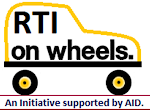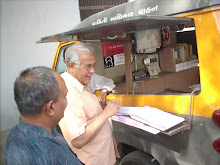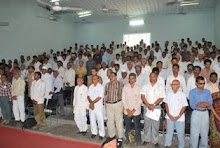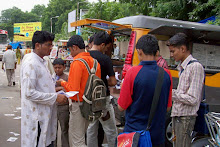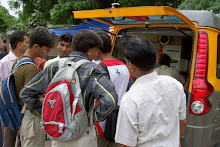Hindustan Times: Sikar: Sunday, August 13, 2017.
In 2005, an
RTI application by Kailash Mina revealed that hundreds of stone crushers were
operating in Neem Ka Thana locality without approval, putting at risk people in
nearby villages from the dust cloud that mining produced.
India is days
away from celebrating its 70th Independence Day: A remarkable journey for a
large and diverse nation with a flourishing democracy that accords its citizens
powerful social and economic freedoms.
Independence
has helped people and communities to smash barriers of caste, class, gender,
ability and faith and achieve their dreams. But structures of oppression
persist, and many people languish in islands of darkness where freedoms are few
and choices absent.
HT brings you
stories from across our nation, of hope, courage and perseverance in “free
India” that reflect the actual promise of independence, and of isolation, hate
and despair that stalk the “unfree India” among our midst.
In Part 3,
read about the inspiring story of an RTI activist story and about a woman who
is fighting free India’s bane: Caste. Read RTI activist Kailash Mina’s story
here:
It’s
difficult to reach Kailash Mina after eight at night. An automated voice from
the service provider greets people, saying the mobile is switched off.
But few know
the reason behind this strange routine that Mina, an RTI activist, religiously
follows.
“If my phone
is kept functioning at night, the threats never stop, with the callers
constantly hurling abuses at me. I get enough threats in the day to keep up
with more in the night,” says Mina.
For the last
two decades, Mina has been a lone ranger in Rajasthan’s Sikar, a major mining
hub. His journey reveals the challenges of taking on powerful lobbies, but also
the possibilities of civic action in free and democratic India.
Battling
discrimination
It was in a
bus in the early 1970s that Mina first experienced social discrimination.
“I had fever
and my mother was taking me to the doctor in the nearest city when an upper
caste family boarded the bus. My mother had to vacate her seat and sit on the
floor because we were from the Mina caste, which is considered low,” he
recalled.
This incident
came back to haunt Mina in 1999, when children in Bhudoli village had their
faces blackened and heads shaved by upper castes over a petty dispute.
“The kids
were made to ride donkeys which circled the entire village. We helped organize
a huge movement against it,” said Mina. He then got engaged in activism, and
soon began using RTI.
Using RTI
In 2005, an
RTI application by him revealed that hundreds of stone crushers were operating
in Neem Ka Thana locality without approval, putting at risk people in nearby
villages from the dust cloud that mining produced.
“Over 1,000
mines are operating in Neem Ka Thana area which has resulted in severe
degradation of environment. Following our RTI application in 2005, we
successfully managed to stop the government from acquiring land of the
villagers for mining purposes after declaring it barren,” said Mina.
This,
however, generated a backlash.
 |
| Mining underway close to the Rela dam in Sikar district of Rajasthan. (Deep Mukherjee\HT Photo) |
“I was
standing a few feet away from Mina near Badiya Mod, when I saw around 7-8 men
armed with iron rods attack him. If we hadn’t rushed to his aid, they would
have killed him,” says agriculturist Chagan Singh.
Nobody was
arrested for the assault as the police submitted a final report on the matter
saying that no case could be made out.
The price of
activism in an area dominated by the mining mafia is steep. Apart from the
personal attacks and life threats, Mina also had to face the brunt of the law,
resulting in close to two dozen cases on him.
“There would
be times when I would sit on a dharna at a village and the police slapped cases
on me saying that I was trying to grab the land and treat me as an encroacher,”
said the activist.
Everyday
resistance
His phone
rings and a conversation in Marwari follows with Mina as he inquires whether
work on a road being built near a Dalit settlement has started.
“The local
administration had overlooked the Dalit colony when it came to building the
road. This is what we are fighting against, the social discrimination,” said
Mina.
The deep
rumble of stone crushers can be heard as one drives along the serpentine roads
leading up to the many clusters of mines that have been dug up in this area.
“Such is the
clout of mining mafia that if the villagers object to the constant blasting
that result in earthquake-like-situations every day, they call the police to
silence the dissenters,” said Mahesh Saini, a 21-year-old associate of Mina,
who too has now started facing threats.
As Mina and
his associates inspect a mine barely a few hundred meters of Kansawati, a small
water body flowing through the area, the stone crushing unit in front of him
abruptly comes to a stop.
A few men
with their faces covered throw furtive glances at Mina’s direction, still more
than five hundred meters from the mining site.
“Now all the
mine owners have been notified over phone that I am in the area, that too with
journalists. We won’t see much mining action today now that they have got
alerted,” said Mina.
But after
thinking for a moment, he smiled wryly, “It seems that I will be getting more
threatening calls than usual today evening. I will have to switch off the phone
much earlier.”





